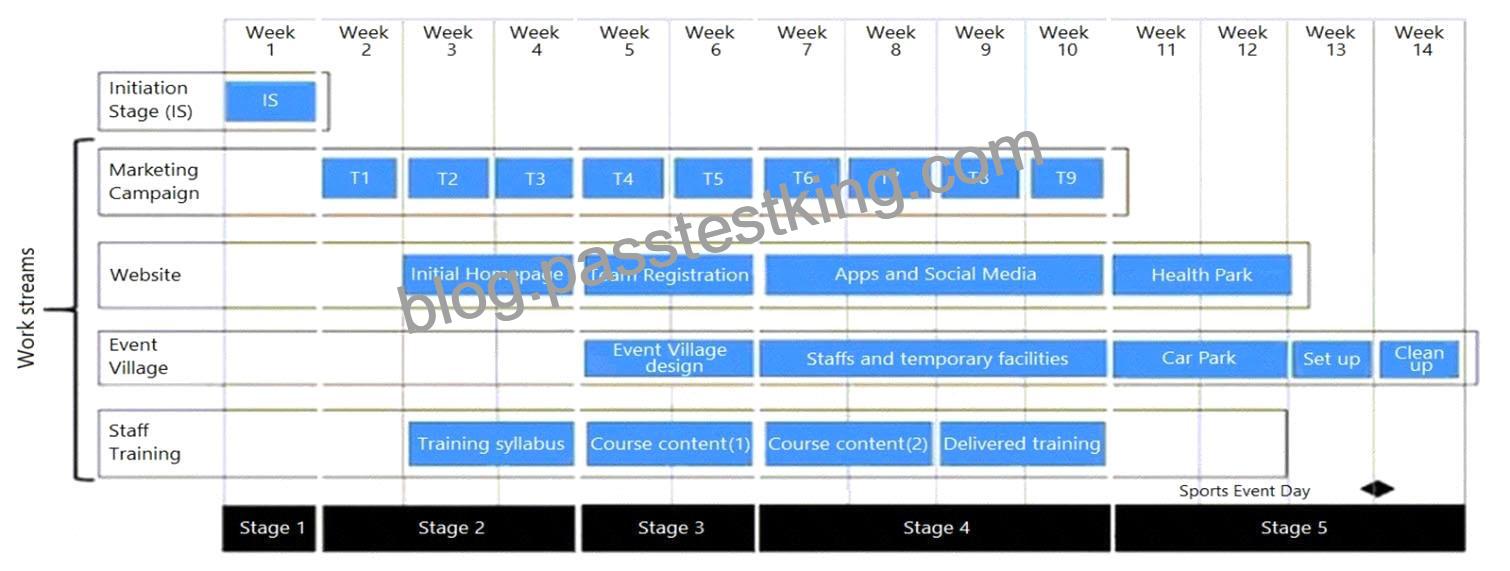NEW QUESTION 20
Project scenario – Get fit with football!
(Note: The companies and people within the scenario are fictional)
Introduction
A Local Government Authority (LGA) has decided to organize a six-a-side football tournament. The tournament will contribute towards achieving the targets set by a national initiative to improve the fitness of children under the age of 16. As part of the LGA’s policy of self-funding, this has to be achieved at zero cost to the LGA (and therefore the local tax payer). The cost of the event will be covered through fees paid by teams registered to take part in the tournament, sponsorship and monies raised during the day. Any surplus would be used for the maintenance of local sports centres.
Teams can register under one of several age groups for both boys and girls. In addition, family members are asked to attend to provide support.
This sports event is designed to be a family day out. The football tournament will have an event village including a kidz’-zone, catering, car parking, mobile changing rooms and toilets. The tournament will take place on the LGA-owned football pitches near the centre of the town, although space is somewhat limited.
Scope
The initial scope of the project includes:
a marketing campaign to promote the event;
a celebrity to open the event;
a website to provide information about the event and handle applications; an event village to support the ‘family day out’; the training of LGA staff as volunteers to run and support the event; back-office processes to handle the applications; fundraising to cover the cost of the event.
The project has been set up with four work streams to deliver this work:
1. Marketing
2. Website
3. Event Village
4. Staff Training
Project Background
The LGA have extensive experience in using PRINCE2 and will run the event as a single project. The project manager is fully conversant with PRINCE2 Agile. One office in the LGA building in the centre oftown has been given to the project for the entire duration. The office is across the corridor from the Marketing Department and the project manager has already put a sign on the door that says ‘Mission Control’.
Timeline
An initial timeline has been suggested and is shown in the following diagram. The timeline may evolve due to the agile ways of working. The timeline shows how work streams are broken down into work packages and/or timeboxes.

Event Village – Additional information
The aim of the event village is to provide a range of services and activities for anyone attending the football tournament.
The event village will comprise a number of work packages:
1. Event village design
2. A ‘kids-zone’ which includes trampolines and swings, as well as the opportunity to try out other sporting activities
3. Stalls which will be sold to local businesses to raise funds for the event:
Refreshment stalls within a large food tent. The LGA is keen to promote the culinary diversity of the town whilst adhering to the objective of eating healthily.
There are 30 vendor stalls selling products related to the event.
The LGA has five stalls to promote their longer term aims and to demonstrate current and future initiatives.
4. A car park for 200 cars.
5. Temporary facilities including changing rooms, toilets and shower facilities.
6. Dismantling of the event village and clean up.
The Event Village Team is assembled using staff from various LGA departments who have no experience of working with agile.
Using the Project Scenario and Event Village Additional information, answer the following question:
There is limited space in the Event Village to accommodate all of the equipment, e.g. the trampolines, ‘kidz- zone’, food tent, car park and changing rooms.
It is difficult to assess whether there is sufficient space from the design drawings. One of the team has suggested physically drawing out the actual space occupied by each facility at the site.
Which statement BEST describes whether this approach is a good application of the frequent releases focus area?
Creating a physical representation of the space occupied by each facility allows the team to visualize and assess the spatial arrangement more effectively. This tangible output is beneficial for the project, providing a clear understanding of how the various components fit together within the limited space, which aligns with the principle of delivering usable outcomes frequently.




